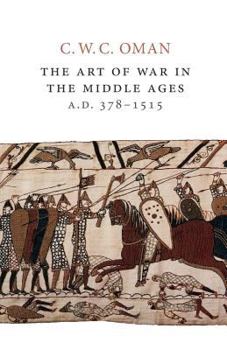The Art of War in the Middle Ages, A.D. 378-1515
Select Format
Select Condition 
Book Overview
This history of medieval warfare, originally written in 1885 when its author--later one of the great medievalists--was still an undergraduate at Oxford, remains for students and general readers one of... This description may be from another edition of this product.
Format:Paperback
Language:English
ISBN:1503145301
ISBN13:9781503145306
Release Date:December 2014
Publisher:Createspace Independent Publishing Platform
Length:162 Pages
Weight:0.47 lbs.
Dimensions:0.4" x 5.5" x 8.5"
Customer Reviews
5 ratings
One of the best sources of how war was fought in the Hundred Years War
Published by Thriftbooks.com User , 17 years ago
I read this book for a graduate course in medieval history. Charles Oman's great book "The Art of War in the Middle Ages" is a great introductory work for warfare of the period. It is especially useful for battle descriptions of English wars against the Scottish, and for the Hundred Years War. Oman writes that the lesson of the Battle of Falkirk in 1298, was clear for any competent military commander to follow; cavalry alone could not defeat the Scottish squares, but archers supported by cavalry could easily break them. These tactics would be successfully repeated by Edward III against the Scots at Hallidon Hill in 1333, and Neville's Cross in 1346, not to mention in his invasion of France Edward I's most important contribution to advancing the war fighting capability of Britain was in the battlefield tactics that he employed. It cannot be stressed enough that his use of mixed cavalry and archery was a monumental leap in battlefield tactics, as well as the precursor in making the longbow a force multiplier during the Hundred Years' War. The military record of Edward II, who reigned from 1307-1327, was abysmal. Charles Oman spoke on behalf of all historians who wrote about Edward II's lack of military prowess, and was justifiably unflattering in his critique of Edward II's military acumen. Most of what Edward I won on the battlefields in Scotland, Edward II ineptly lost. Edward III's strategic and tactical abilities were on full display during the Hundred Years' War. One of the most important tactical innovations that Edward III instituted to increase the fighting capability of the English army before the start of the Hundred Years' War was the introduction of mounted archers to its ranks. Oman took notice of the importance of Edward III's tactical innovation. Mounted archers rode ponies for quick transport to the battlefield, and then they would dismount to shoot their longbows in battle. Undoubtedly, Edward III learned from the previous one hundred years of his predecessors' fighting the Scottish, that too many times the Scots outmaneuvered the English; thus, they escaped from having to fight a battle advantageous to the English. Edward III was going to do all he could to make sure that this did not happen to his army. Oman's research shows muster records from 1334 listing mounted archers for the first time as part of Edward III's expedition into Scotland. This was Edward III's second largest campaign against an enemy during his reign. The expedition served as an excellent opportunity for Edward III and his army to prove their new tactics, which they would put to good use a dozen years later in France. Recommended reading for those interested in medieval history, and military history.
Must Read for those interested in fall of Rome/Byzantine
Published by Thriftbooks.com User , 20 years ago
Oman actually starts out before 378 giving comment to the Roman military sysem. I lost track of a lot of the details but really enjoyed the book. With his detail of the battles he paints a good picture. He also gives some connecting information as to why the battles were taking place. The politics, powers and so on that were taking place. This book gave me a new appreciation for the Byzantines. Any one interested in the crusades would also do well to understand how the Byzantines fought and how the middle east looked when the crusaders showed up. Since everyone talks about crusades and the holy-land now days it is good to understand just what those words mean. This book offers more than great battles that should be put to the screen.
immensely readable
Published by Thriftbooks.com User , 22 years ago
This is an excellent and fascinating work. I highly recomend it for anyone interested in warfare, the middle ages, or both. It is full of well-researched insights and synthesizes and provides a broad general framework for understanding warfare in this period. Serious scholars or those seeking to use this as a textbook should note that the original version that forms the basis of this book was written a century ago and is probably outdated, despite the rewritten portions. However, the greatest strength of this book is that it is extraordinarily well-written, and a pleasure to read.
Readable, insightful, and informative.
Published by Thriftbooks.com User , 25 years ago
Oman provides an excellent, well-researched look at the arms, tactics, and strategies of various medieval armies. He covers the rise of the era of heavy calvary, and describes how it was replaced by the English longbow and the Swiss pikeman. His discussion of the various battlefield tactics unique to each army, as illustrated through maps of many of the major battles, proves both informative and entertaining. This is by far the most "readable" and authoritative book on the subject I have read to date.
For the person who wants to know about war in the middle age
Published by Thriftbooks.com User , 25 years ago
but not much else. It is a great work to tell about organization, armor, and weapons. It is surprisingly easy reading for the time period and considering the genius of the man who wrote. If you want to know about the political intrigues, you must go elsewhere though.




